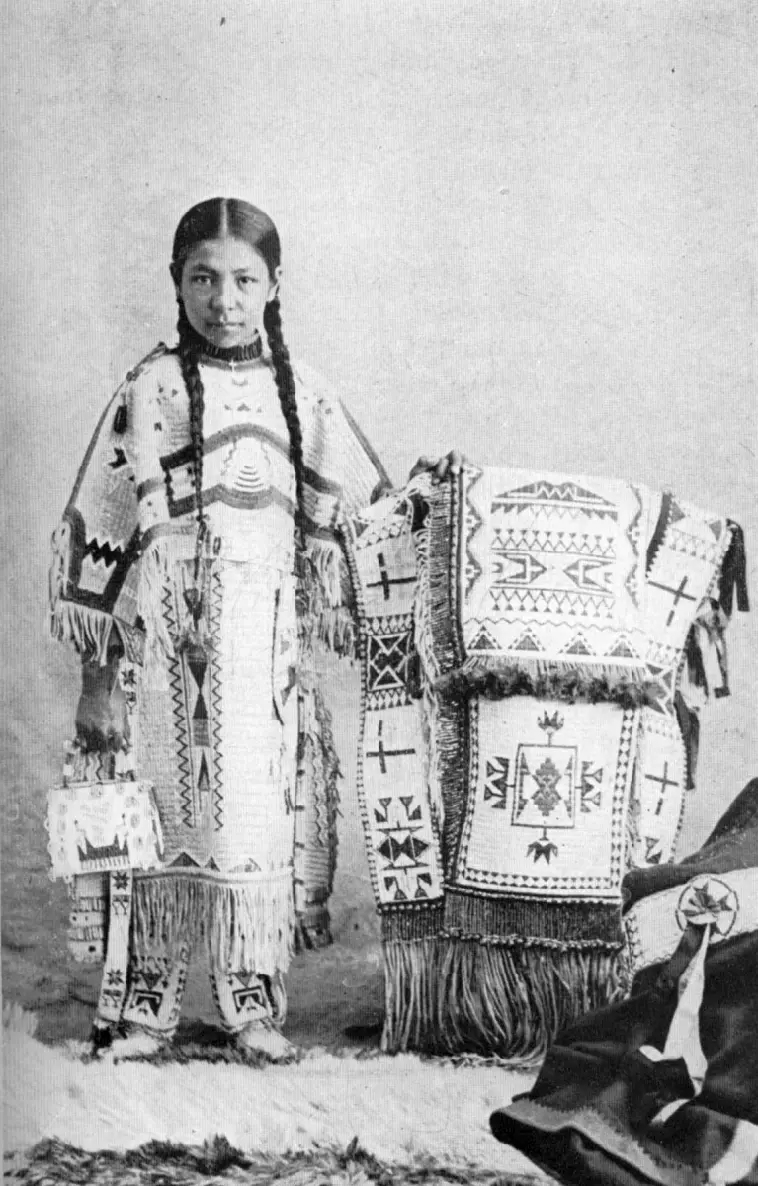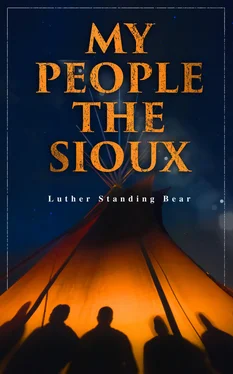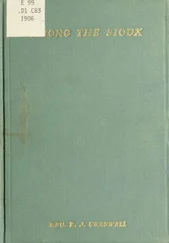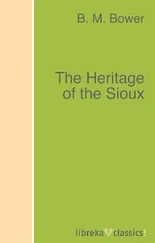When the man on the pony saw us, he signaled. It was my father, out searching for us. I was so glad to see him. The extra pony was my own little animal. Father lifted me to its back and placed one of the smaller boys on behind me, taking another little fellow up behind on his own mount. In this way we returned to camp, very tired, and so happy to be home again.
Then father called the old camp crier to announce that his son ‘Ota Kte,’ or ‘Plenty Kill,’ had brought home his first meat, and that Standing Bear was giving away another pony in consequence. This pony was given to another old man. My father felt so proud of me that he was happy to do this.

ONE OF THE AUTHOR’S NIECES, WITH SOME EXCEPTIONALLY FINE BEAD-WORK
Table of Contents
Our home life began in the tipi. It was there we were born, and we loved our home. A tipi would probably seem queer to a white child, but if you ever have a chance to live in one you will find it very comfortable—that is, if you get a real tipi; not the kind used by the moving-picture companies.
When I was a boy all my tribe used tipis made of buffalo skins. Some were large; others were quite small; depending upon the wealth of the owner. In my boyhood days a man counted his wealth by the number of horses he owned. If a tipi was large it took a great many poles to set it up; and that called for a great many horses to move it about when camp was broken.
A small tipi required about twelve poles to set up, and they were not very long, so that only about two horses were required when on the move. But a large tipi required from twenty-five to twenty-seven poles, and it was necessary that they be quite a bit longer. It required about six horses to transport properly a large tipi when camp was broken. We were at liberty to move any time we chose. So, if a man wanted a large tipi, he must first be sure he had horses enough to move it.
My father’s tipi was the largest in our tribe. When we made camp, all the rest of the tribe would camp at a distance, as they were afraid the wind might get too strong in the night and knock our tipi over on them.
At the top of the tipi were two flaps which served as wind-breaks. If the wind blew too hard from the north, then the flap on the north side was raised; if it came from the south, the south flap was raised. Our tipis were always set up facing the east, so we always had the west at our backs.
In case of rain, both flaps were closed down and tied to a stake driven in the ground. If a tipi was set up right, there never was any smoke inside, as the flue was open at the top. If snow fell heavily, it banked up all around the outside of the tipi, which helped keep us warm. On nights when there was a cold, sleeting rain, it was very pleasant to lie in bed and listen to the storm beating on the sides of the tipi. It even put us to sleep.
To erect a tipi properly, three poles were first laid on the ground, one longer than the others. The long one was to serve as the front-door space. These three poles were tied together with a rawhide rope and then were raised up. The tipi covering was then laid on the ground and doubled over. One pole was then laid on the center of the back and tied at the top.
All the other poles were placed around the three poles which were now standing, except two, and they were left for the flaps. After all the poles were in place, the one that supported the tipi was placed. One end of the tipi was now pulled around to the front-door space, and the other end was pulled around to meet it.
A boy would then climb to the top of the tipi and put the pins in the front to hold the tipi together. The women then staked the tipi down with larger pins made of cherry wood. These stakes were about fifteen inches long, and the bark was left on them for about two inches. This kept the tipi from slipping up on them.
In the center of the tipi a large fire was built, and it was nice and warm, regardless of the weather outside.
Doubtless you are wondering what sort of furniture we had in our homes at that time. We did not have very much, but there was sufficient to keep us happy.
We used no high bedsteads. We had a tripod tied together with a buckskin string. Straight branches were also strung to a buckskin thong, and these hung down in front of the tripod. These branches varied in size, and were narrow at the top and wider at the bottom. They were attached to the buckskin thong in such a manner that they could be rolled up when it came time to move camp. On top of these small branches was hung a buffalo skin. This was fastened on top of the tripod by the nose. The branches kept the buffalo skin from sinking in between the two sticks of the tripod and served as a back-rest. These tripods stood about five feet high. The skins were quite long, so that a portion of them trailed on the ground. In the center, another skin was laid. This made a very pretty bed and was fine to sleep in. The beds were made all around the sides of the tipi.
At the rear of the bed, against the tipi wall, a tanned hide was tied to the poles, on which was painted the history of the family. These were to the Indian what pictures were to the white man’s home. This painted robe could be worn as a blanket when attending a dance.
At the back of the bed, and in front of this painted skin, the woman of the house kept all the rawhide bags. These bags were very fancy affairs. They were made by the women. When a buffalo skin was brought in for this purpose, it was first staked to the ground and the women scraped all the meat off. The skin was then washed with water to make sure it was clean. While the skin was yet damp, it was painted. Our paints in those days were made from baked earth and berries. The paint-pots were turtlebacks. The brush used by the artist was not really a brush, but a small bone, rather ragged on the edge, so it would hold the paint. The straight-edge or ruler was a very straight stick.
Then the woman who was to act as the artist got everything ready to decorate the hide. The paints were mixed with water. The woman kneeled on the skin and designed her patterns, putting in all the colors which she thought pretty and suited her fancy.
The bag had to be painted in such a manner that the two sides, when folded over, met in the center. Holes were made along the edges of these two ends, and a buckskin string was run through to serve as a tie-string. The decorated side of the bag was tied together. The other side also had a buckskin string, which was fastened to the saddle when on the move.
After the big bag was made, the scraps from the hide were used up. Some pieces were cut for moccasin soles. These were not painted; but the pieces which the women expected to make bags from were all painted at the same time as the big bag. The women made one little bag which served as a sort of workbox. In this the woman kept all the tools she needed in her sewing—the awl and sinews. She also made another to hold her comb. In those days a comb was made from the tail of the porcupine. Another bag held paints and brushes; sometimes knife-cases were made from any of the left-over pieces of hide. All these were painted in pretty designs, and this work was always done by the women. The bag that held the war-bonnet was also painted and decorated, but all war articles were painted by men.
Some of these bags held the dried meat for the winter’s supply. Others held sinew and scraps of skin and moccasin soles. In fact, these bags served the Indian just as the white man’s trunk is used by him. The bag that held the war-bonnet always hung on the tripod of the bed. It never was laid on the ground.
Читать дальше













